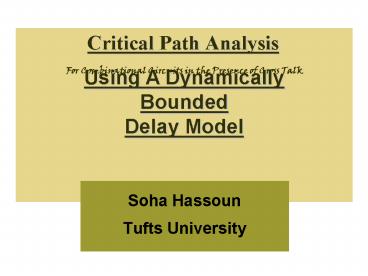Critical Path Analysis PowerPoint PPT Presentation
1 / 25
Title: Critical Path Analysis
1
Critical Path Analysis
Using A Dynamically Bounded Delay Model
For Combinational Circuits in the Presence of
Cross Talk
- Soha Hassoun
- Tufts University
2
Effective Static Timing AnalysisRequires a New
Delay Model
Circuit Gates
Physical Data
Layout
3
New Delay Model
- Desirable Characteristics
- Abstract independent of extraction methods
- Flexible run time v.s. accuracy
- Extensible model different effects
- Goal
- functional, timing, and physical Co-Verification
4
The Dynamically Bounded Delay Model
?cj
?ci
Dmax ? ?ci if condition ci
holds Dmin ? - ?cj if condition cj
holds
5
The Dynamically Bounded Delay Model
?cj
?ci
- Advantages
- Abstract, flexible, extensible
- Require novel verification algorithms
6
Using The DynamicallyBounded Delay Model
- The Problem
- timing analysis for combinational circuits in
the presence of cross talk - modeling cross talk
- formulating the problem
- results
7
Delays due to Capacitive Coupling
vIn
v (victim)
aIn
a (aggressor)
8
Modeling Opposing Capacitive Coupling
? v,a 1 iff coupling holds
Dmax
9
Capacitive Coupling When Does it Affect Delay?
vIn
aIn
10
When Does Coupling Hold?
?v,a 1 iff coupling holds
11
When Does Coupling Hold?
?v,a 1 iff coupling holds
12
Timing Analysis in the Presence of Cross Talk
Problem Minimize long arrival times, A, and
maximize short arrival times, a, subject to
Late Arrival Constraints Av ? AvIn ? v ? v,a
? v,a Early Arrival Constraints av ? avIn ? v -
?v,a ? v,a Coupling Constraints ?v,a 1 ?
MinIa-? ? MaxIv ? MaxIa ? ?v,a
1 ? MinIa-? ? MinIv ? MaxIa ?
13
Towards a Mixed Integer Linear Program
Coupling Constraints ?v,a 1 ? MinIa-? ?
MaxIv ? MaxIa ?
? (MaxIv ? MinIa-? ) and
(MaxIv ? MaxIa ?)
14
Equivalence Relationship to MILP
- ?v,a 1 ? ? AND ?
?v,a 1 ? (? ? ? 2)
? ? - 2 ? ? 0 ? ? - ? ? 1
15
Timing Analysis in the Presence of Cross Talk
Problem Minimize long arrival times, A, and
maximize short arrival times, a, subject to
Late Arrival Constraints Av ? AvIn ? v ? v,a
? v,a Early Arrival Constraints av ? avIn ? v -
?v,a ? v,a Coupling Constraints ?v,a 1 ?
MinIa-? ? MaxIv ? MaxIa ? ?v,a
1 ? MinIa-? ? MinIv ? MaxIa ?
16
Timing Analysis in the Presence of Cross Talk
Solution solve a Mixed Integer Program via a
commercial solver. Solve for both for minimum
and maximum arrival times (MM Analysis)
Improvement Separate the Min and Max Analysis by
using lower and upper bounds obtained via
PERT (Separate Analysis)
? 1 ? MinIa-? ? MaxIv ? MaxIa?
17
Experimental Setup
- Commercial MILP solver
- ISCAS benchmark Circuits (160 - 2400)
- Mapped using SIS
- Varied of caps, random delays
- Goals
- validate our equations
- examine run times and problem size
18
Reduction in Long Critical PathsMM
AnalysisNormalized to Appropriate PERT
Coupling
19
Same Critical Path? MM Analysis -- 30
couplingNormalized to Appropriate PERT
no
no
no
20
Reduction in Critical Long PathMM Analysis v.s.
Separate Max Analysis
21
Run Time of Sepearate Analysisnormalized to MM
MM Run Time
22
Reduction in EquationsMM Analysis -- 30 cap
23
Conclusion
- Novel delay model
- dynamically bounded delay model
- Static Timing Analysis with Cross Talk
- requires both min and max arrival analysis
- model as a Mixed Integer Linear Program
- reasonable to separate the min and max analysis
24
Future Work
- An efficient algorithm?
- Extracting dynamically bounded delay models
- Use the model in
- static timing analysis for circuits with
level-sensitive latches - combine functional timing information to
analyze coupling effects
25
- ACMs Special Interest Group
- on Design Automation invites you to attend
- The Ph. D. Forum at DAC
- Tuesday, June 6, 7-9 p.m.
- following DAC cocktail party
- Room 502A
- free dinner
- A chance to interact with 30 P.h. D. students
- specializing in CAD. Your feedback
- on their work would be greatly appreciated!

